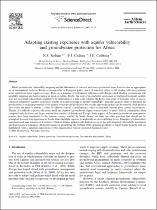 ResearchSpace
ResearchSpace
Adapting existing experience with aquifer vulnerability and groundwater protection for Africa
JavaScript is disabled for your browser. Some features of this site may not work without it.
- ResearchSpace
- →
- Research Publications/Outputs
- →
- Journal Articles
- →
- View Item
| dc.contributor.author |
Robins, NS

|
|
| dc.contributor.author |
Chilton, PJ

|
|
| dc.contributor.author |
Cobbing, JE

|
|
| dc.date.accessioned | 2007-06-12T07:43:25Z | |
| dc.date.available | 2007-06-12T07:43:25Z | |
| dc.date.issued | 2007-01 | |
| dc.identifier.citation | Robins NS, Chilton PJ, Cobbing JE. 2007. Adapting existing experience with aquifer vulnerability and groundwater protection for Africa. Journal of African Earth Sciences, Vol 47(1) pp 30-38 | en |
| dc.identifier.issn | 1464-343X | |
| dc.identifier.uri | http://hdl.handle.net/10204/568 | |
| dc.description | http://www.sciencedirect.com/science/journal/1464343X | en |
| dc.description.abstract | Whilst groundwater vulnerability mapping and the delineation of resource and source protection zones have become an appropriate set of management tools for Britain as incorporated in European policy, much of semi-arid Africa is still dealing with more pressing issues centred on water supply coverage. There are a number of fundamental differences with Britain which disallow conventional vulnerability mapping and land zonation in much of Africa. Firstly, the scale of groundwater occurrence in weathered basement aquifers does not encourage vulnerability mapping to be undertaken at a field scale, whereas the Karoo and some of the larger areas of unconsolidated sedimentary aquifers could more readily be zoned according to aquifer vulnerability. Secondly, analysis needs to disregard the productivity (or recharge potential) of the aquifer so that poorly productive but socially important aquifers can be assessed. Such practice also avoids the need to identify a value for effective rainfall, a problematical value in semi-arid climates given current uncertainties. Thirdly, it is difficult to protect the many small and dispersed groundwater supply sources typical of many African communities when compared with the fewer and larger sources characteristic of Britain and Europe. Some aspects of European groundwater management practice have been transferred to the African context, notably by South Africa, but there are other practices that should not be attempted. Lessons from experience in South Africa highlight capacity to implement as a key inhibiting factor. Examples of vulnerability assessment and land zonation in a variety of African settings indicate only limited success so far with standard vulnerability assessment and land zonation techniques. Alternative means of quantifying the problem of the optimum proximity of the pit latrine from the well are highlighted, with a minimum separation of 10 m suggested for typical weathered basement rocks. | en |
| dc.language.iso | en | en |
| dc.publisher | Elsevier Ltd | en |
| dc.subject | Aquifer vulnerability | en |
| dc.subject | Source protection | en |
| dc.subject | Groundwater protection | en |
| dc.subject | Groundwater management | en |
| dc.subject | Africa | en |
| dc.subject | Water resources | en |
| dc.title | Adapting existing experience with aquifer vulnerability and groundwater protection for Africa | en |
| dc.type | Article | en |
| dc.identifier.apacitation | Robins, N., Chilton, P., & Cobbing, J. (2007). Adapting existing experience with aquifer vulnerability and groundwater protection for Africa. http://hdl.handle.net/10204/568 | en_ZA |
| dc.identifier.chicagocitation | Robins, NS, PJ Chilton, and JE Cobbing "Adapting existing experience with aquifer vulnerability and groundwater protection for Africa." (2007) http://hdl.handle.net/10204/568 | en_ZA |
| dc.identifier.vancouvercitation | Robins N, Chilton P, Cobbing J. Adapting existing experience with aquifer vulnerability and groundwater protection for Africa. 2007; http://hdl.handle.net/10204/568. | en_ZA |
| dc.identifier.ris | TY - Article AU - Robins, NS AU - Chilton, PJ AU - Cobbing, JE AB - Whilst groundwater vulnerability mapping and the delineation of resource and source protection zones have become an appropriate set of management tools for Britain as incorporated in European policy, much of semi-arid Africa is still dealing with more pressing issues centred on water supply coverage. There are a number of fundamental differences with Britain which disallow conventional vulnerability mapping and land zonation in much of Africa. Firstly, the scale of groundwater occurrence in weathered basement aquifers does not encourage vulnerability mapping to be undertaken at a field scale, whereas the Karoo and some of the larger areas of unconsolidated sedimentary aquifers could more readily be zoned according to aquifer vulnerability. Secondly, analysis needs to disregard the productivity (or recharge potential) of the aquifer so that poorly productive but socially important aquifers can be assessed. Such practice also avoids the need to identify a value for effective rainfall, a problematical value in semi-arid climates given current uncertainties. Thirdly, it is difficult to protect the many small and dispersed groundwater supply sources typical of many African communities when compared with the fewer and larger sources characteristic of Britain and Europe. Some aspects of European groundwater management practice have been transferred to the African context, notably by South Africa, but there are other practices that should not be attempted. Lessons from experience in South Africa highlight capacity to implement as a key inhibiting factor. Examples of vulnerability assessment and land zonation in a variety of African settings indicate only limited success so far with standard vulnerability assessment and land zonation techniques. Alternative means of quantifying the problem of the optimum proximity of the pit latrine from the well are highlighted, with a minimum separation of 10 m suggested for typical weathered basement rocks. DA - 2007-01 DB - ResearchSpace DP - CSIR KW - Aquifer vulnerability KW - Source protection KW - Groundwater protection KW - Groundwater management KW - Africa KW - Water resources LK - https://researchspace.csir.co.za PY - 2007 SM - 1464-343X T1 - Adapting existing experience with aquifer vulnerability and groundwater protection for Africa TI - Adapting existing experience with aquifer vulnerability and groundwater protection for Africa UR - http://hdl.handle.net/10204/568 ER - | en_ZA |





